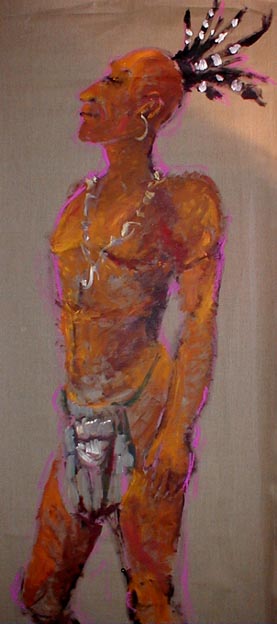In the kitchen, turkey bones boil for broth. "I put those in the freezer," my brother-in-law tells me over the telephone, "so I can pop out a cube and finish a sauce." They had 14 for dinner. My brother-in-law's sister made centerpieces, everyone raved about. Later in the call, my sister and I laugh about how every year we made a "log cabin" out of Lincoln logs for the dinner table. When I left home, she added two styrofoam pilgrims to the maquette.
The butcher cooked our turkey this year. While my fridge/freezer is larger, my oven is smaller. I am more of a stove-top chef, anyway. A small group this year, just the five of us enjoyed the usual fixings. Afterward, I made a turkey curry (we ate it at the restaurant) and a turkey risotto.
I painted a very large Indian and Pilgrim for our dining room -- each nearly six feet tall. I could only find Squanto in the form of a bust on the Internet -- I mixed him with Massoit's sculpted body. The two were facing different directions -- the pictures were doctored with a fair amount of imagination. I'd been thinking of Squanto because I saw him mentioned on the outside of a sack for French "Polaine" bread. Squanto, it said, introduced corn to the Europeans, who came to America. More importantly, Squanto's knowledge of English (learned in prison) made him a great help to the Pilgrims.
The Pilgrim is taken from the statue of "The Puritan" by Gaudens, in Springfield, Massachusetts. It is such a scary statue I can recall it in great detail, as it looms over the quad in the center of the city. It stands not far from the bronzes of the Grinch, and Thing One and Thing Two, from the Theodore Geisel stories. Dr. Seuss was from Springfield, along with the Puritan. It calms me to remember that.
When I look at the two giants in my dining room, it is apparent where some of the problem lay. The Indian stands, with a minimum of clothes, and a nice array of feathers, opposite a buttoned up Englishman, clutching a Holy Bible. There is no doubt in my mind who I would rather be, bigger than life. Unfortunately, my instincts are more that of the Pilgrim -- I grew up in the cradle of that civilization, in New England.
Thursday morning, at the restaurant, a Sikh came in for coffee. For me, he was not such an oddity, but at the restaurant he was a sensation. Nicole took his photo emphasizing his bright orange turban. The regulars at the bar asked him where he was from and what he was doing there -- visiting, from Punjab. Blair and I were the translators. He will forever be recalled here as "the Sikh". Without figures bigger than life we cannot have heroes.
The first Sikh I knew was in Seattle, and his name was Raj. In the kitchen he showed me the Tandoori oven, bragging, "I can cook a man in that oven." He was always warm and friendly, and I looked forward to his rice birjani most Friday nights.
There is a marked lack of diversity in continental Europe, save for immigrants from former colonies, heavily imbued with the prevailing culture, or those poor individuals imported to perform the lowest tasks. In France, Germany, Italy, it is unthought of to have a non-native official. Steady habits prevail. It is a lesser place for that.
I am inspired to paint more heroes and thieves: Gypsies, doctors, Flamenco dancers and street cleaners -- images that populate our minds and make us think, otherwise known as conversation pieces. I ignore the bad rap given stereotypes during the "politically correct" 1990s. It isn't the generalization that is bad but the characteristic immortalized. It is better to think of a dog as "man's best friend" than to recall his bite.
I listen to a radio interview with an American Jazz musician on Paris Jazz, 89.9FM. He was successful 30 years ago, but frequently not paid. He fell into living on the street, before he was resurrected and took up Jazz once again. I am flabbergasted by this contrast, and think "only in America". Destiny and responsibility dictate our lives.
When we enter the restaurant, Michel croons, "Welcome, my Americans." There are people there who only think of us as the Americans, without names. It is an important role I assume. And when people ask us, I always tell them, "yes, most Americans are just like us."
Laurie (painting and text) and Blair PESSEMIER


 Home
Home

 Help
Help

 Search
Search

 Login
Login

 Register
Register

 Broadcast Message to Admin(s)
Broadcast Message to Admin(s)

 « Home
« Home  ‹ Board
‹ Board  Top of this page
Top of this page 
 Pages: 1
Pages: 1

